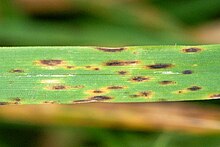| Pleosporaceae | |
|---|---|

| |
| Cochliobolus sativus | |
|
Scientific classification
| |
| Domain: | Eukaryota |
| Kingdom: | Fungi |
| Division: | Ascomycota |
| Class: | Dothideomycetes |
| Order: | Pleosporales |
| Family: |
Pleosporaceae Nitschke (1869) [1] |
| Synonyms | |
|
Pyrenophoraceae | |
Pleosporaceae is a family of sac fungi. They are pathogenic to humans or saprobic on woody and dead herbaceous stems or leaves. [2]
They are generally anamorphic species (having an asexual reproductive stage). [3] The type species is Stemphylium botryosum Wallr. [2]
They have a cosmopolitan distribution worldwide. [4]
History
The family was created in 1869, [1] based on the immersed ascomata and pseudoparaphyses of some species, and it was assigned to Sphaeriales order. It was then placed in the Pseudosphaeriaceae family by Theissen & Sydow (1917a) and then later raised to ordinal rank as the Pseudosphaeriales. [5] Luttrell (1955) assigned Pleosporaceae under the Pleosporales order and treated Pseudosphaeriales as a synonym of Pleosporales. [6] Later, availability of molecular data, and multi-gene phylogenetic studies confirmed the familial placement of Pleosporaceae with respect to other families in order Pleosporales (Lumbsch & Huhndorf 2010, [7] Zhang et al. 2012b). [8] Genera Alternaria, Bipolaris and Stemphylium are more common asexual morphs in Pleosporaceae and they are also saprobes or parasites on various hosts. [2] Boonmee et al. transferred Allonecte from family Tubeufiaceae to family Pleosporaceae in 2011. [9] Ariyawansa et al. (2015c) revised the family and accepted 18 genera into it. [10] According to Wijayawardene et al. (2018), [11] 16 genera were accepted in Pleosporaceae based on morphological and molecular data. Pem et al. (2019c) accepted genus Gibbago in Pleosporaceae based on morphological and molecular data. [12]
Genera
As accepted by Wijayawardene et al. 2020; [13]
- Allonecte Syd. (3)
- Alternaria Nees ex Wallroth, 1816 (360)
- Bipolaris Shoemaker (179)
- Chalastospora E.G.Simmons, 2007 (2)
- Clathrospora Rabenh. (20)
- Cochliobolus Drechsler, 1934 (19)
- Comoclathris Clem.(30)
- Curvularia Boedijn (497)
- Decorospora ( Pat.) Inderbitzin, Kohlm. & Volkm.-Kohlm, 2002 (3)
- Diademosa Shoemaker & C.E. Babc. (4)
- Dichotomophthora Mehrl. & Fitzp. ex M.B.Ellis, 1971 (6)
- Drechslera S.Ito, 1930 (36)
- Embellisia E.G.Simmons, 1971 (3)
- Exserohilum K.J. Leonard & Suggs (113)
- Extrawettsteinina M.E. Barr (2)
- Gibbago E.G.Simmons, 1986 (2)
- Johnalcornia Y.P.Tan & R.G.Shivas, 2014 (4)
- Lewia M.E. Barr & E.G. Simmons
- Macrospora Fuckel (2)
- Macrosporium Fries, 1832 (13)
- Malustela (1)
- Mycoporopsis Müll.Arg. (12)
- Paradendryphiella Woudenb. & Crous, 2013 (2)
- Paraliomyces Kohlmeyer, 1959 (2)
- Platysporoides ( Wehm.) Shoemaker & C.E. Babc. (12)
- Pleoseptum A.W. Ramaley & M.E. Barr (1)
- Pleospora Rabenh. ex Ces. & De Not., 1863 (458)
- Porocercospora Amaradasa, Amundsen, H.Madrid & Crous, 2014 (12)
- Pseudoyuconia Lar. N. Vailjeva (1)
- Prathoda Subram. (2)
- Pseudoyuconia Lar.N. Vassiljeva (1)
- Pyrenophora Fr., 1849 (133)
- Scleroplea (1)
- Stemphylium Wallroth, 1833 (96)
- Tamaricicola Thambug., Camporesi & K.D. Hyde (1)
- Teretispora E.G.Simmons (2)
- Typhicola Crous, 2019 (2)
Figures in brackets are approx. how many species per genus. [13]
References
- ^ a b Nitschke, Verh. naturh. Ver. preuss. Rheinl. 26: 74 (1869).
- ^ a b c "Pleosporaceae - Facesoffungi number: FoF 00500". Faces Of Fungi. 20 April 2015. Archived from the original on 13 June 2023. Retrieved 11 August 2023.
- ^ Pem, Dhandevi; Jeewon, Rajesh; Wedaralalage, Kandawatte; Chethana, Thilini; Hongsanan, Sinang; Doilom, Mingkwan; Suwannarach, Nakarin; Hyde, Kevin David (2021). "Species concepts of Dothideomycetes: classification, phylogenetic inconsistencies and taxonomic standardization". Fungal Diversity. 109: 283–319. doi: 10.1007/s13225-021-00485-7. S2CID 256066153.
- ^ "Pleosporaceae". www.gbif.org. Archived from the original on 28 May 2022. Retrieved 3 August 2022.
- ^ Theissen, F.; Sydow, H. (1917). "Die Gattung Parodiella". Annales Mycologici. 15 (1–2): 125–142.
- ^ Luttrell ES. (1955). The ascostromatic ascomycetes. Mycologia 47: 511–532.
- ^ Lumbsch, H.T.; Huhndorf, S.M. (2010). "Myconet volume 14. Part one. Outline of Ascomycota—2009". Fieldiana Life and Earth Sciences. 1: 1–42. doi: 10.3158/1557.1. S2CID 86529508.
- ^ Zhang, Y.; Crous, P.W.; Schoch, C.L.; Hyde, Kevin D. (2012). "Pleosporales". Fungal Diversity. 53 (1): 1–221. doi: 10.1007/s13225-011-0117-x. PMC 3477819. PMID 23097638.
- ^ Boonmee, Saranyaphat; Zhang, Ying; Chomnunti, Putarak; Chukeatirote, Ekachai; Tsui, Clement K. M.; Bahkali, Ali H.; Hyde, Kevin D. (2011). "Revision of lignicolous Tubeufiaceae based on morphological reexamination and phylogenetic analysis". Fungal Diversity. 51: 63–102. doi: 10.1007/s13225-011-0147-4. S2CID 22946401.
- ^ Ariyawansa Hiran A.; Hyde, Kevin D.; Jayasiri, Subashini C.; et al. (2015). "Fungal diversity notes 111–252 – taxonomic and phylogenetic contributions to fungal taxa" (PDF). Fungal Diversity. 75 (1): 27–274. doi: 10.1007/s13225-015-0346-5. S2CID 62809402.
- ^ Wijayawardene, N.N. (2018). "Notes for genera: basal clades of fungi (including Aphelidiomycota, Basidiobolomycota, Blastocladiomycota, Calcarisporiellomycota, Caulochytriomycota, Chytridiomycota, Entomophthoromycota, Glomeromycota, Kickxellomycota, Monoblepharomycota, Mortierellomycota, Mucoromycota, Neocallimastigomycota, Olpidiomycota, Rozellomycota and Zoopagomycota)" (PDF). Fungal Diversity. 92: 43–129. doi: 10.1007/s13225-018-0409-5. S2CID 256063936. Archived (PDF) from the original on 2020-09-21. Retrieved 2023-08-11.
- ^ Pem, D.; Jeewon, R.; Bhat, D.J.; Doilom, M.; Boonmee, S.; Hongsanan, S. (2019). "Mycosphere Notes 275–324: A morphotaxonomic revision and typification of obscure Dothideomycetes genera (incertae sedis)". Mycosphere. 10: 1115–1246. doi: 10.5943/mycosphere/10/1/22. S2CID 214510340.
- ^ a b Wijayawardene, Nalin; Hyde, Kevin; Al-Ani, Laith Khalil Tawfeeq; Somayeh, Dolatabadi; Stadler, Marc; Haelewaters, Danny; et al. (2020). "Outline of Fungi and fungus-like taxa". Mycosphere. 11: 1060–1456. doi: 10.5943/mycosphere/11/1/8. hdl: 10481/61998.
External links